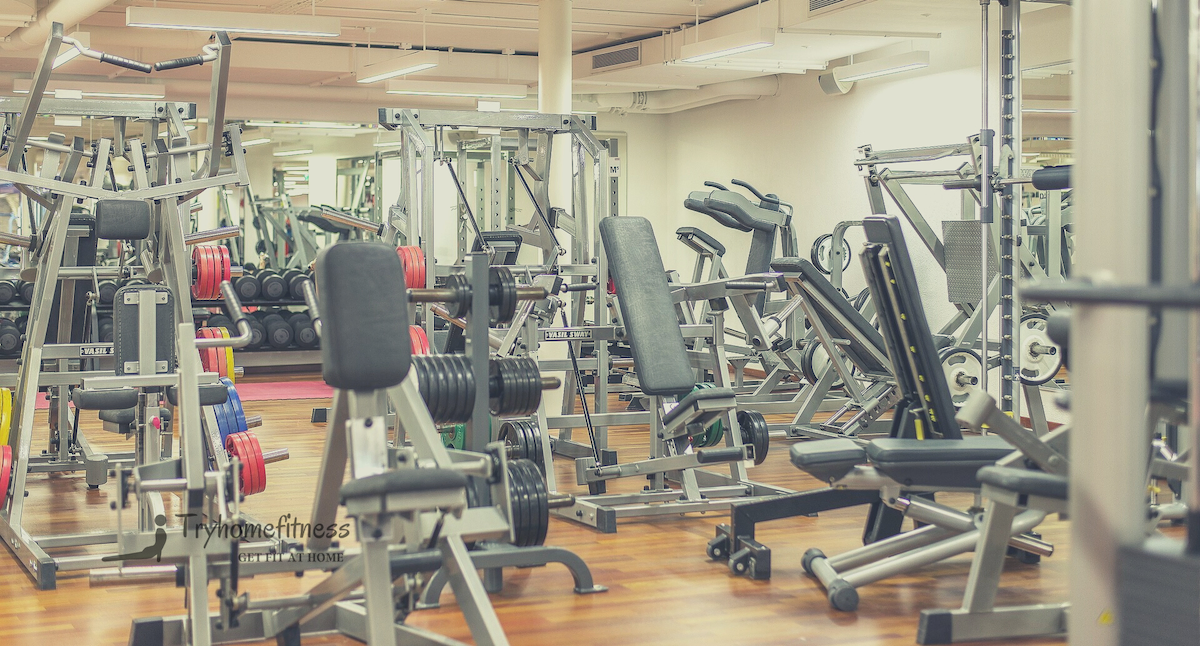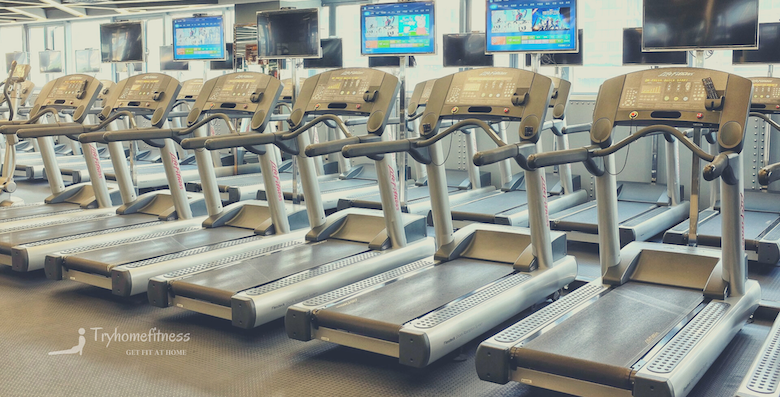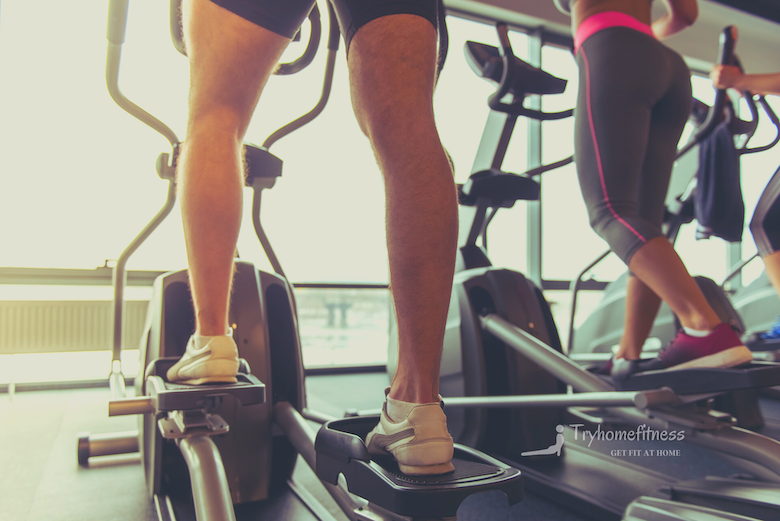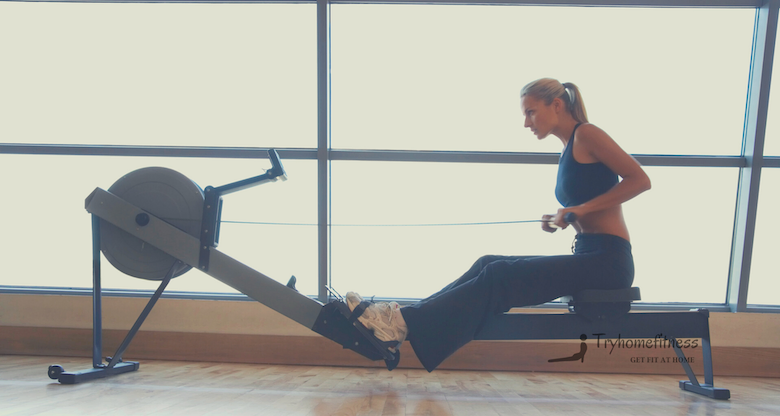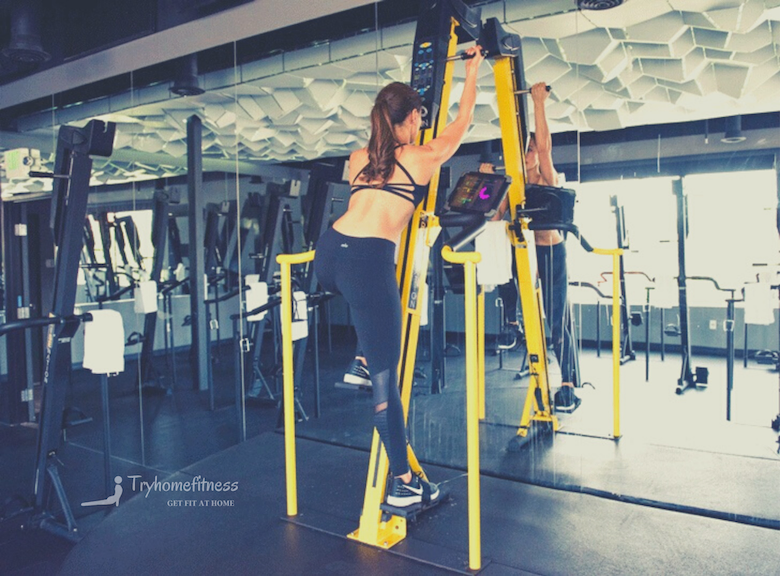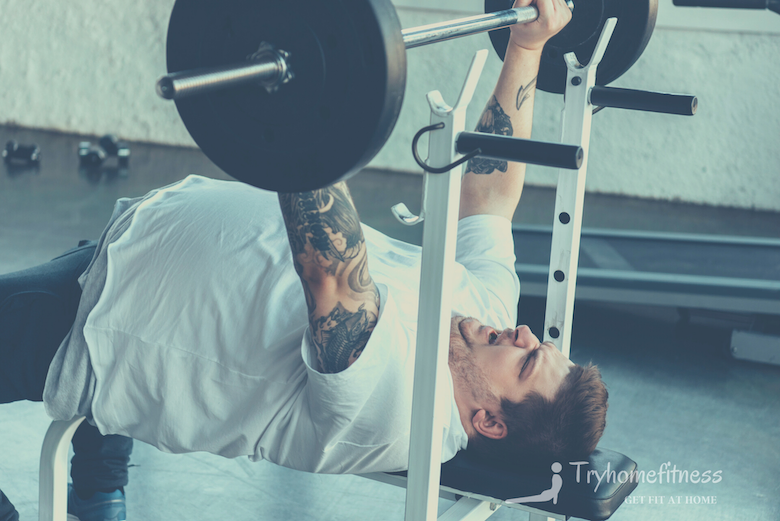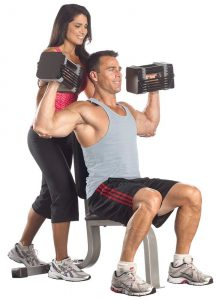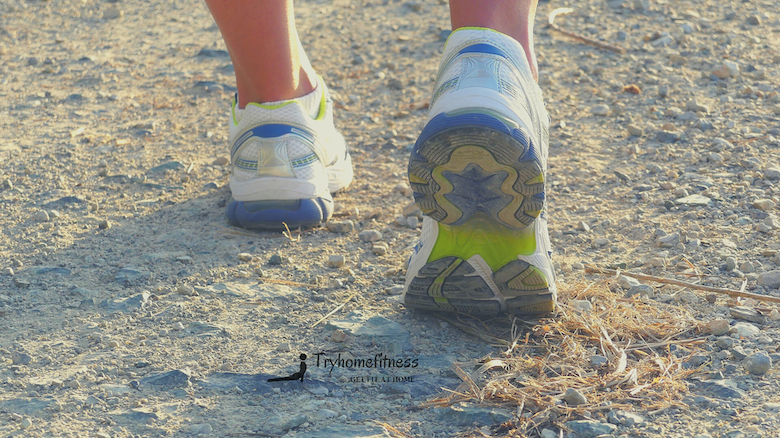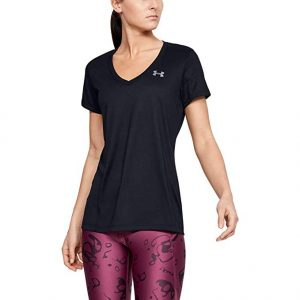As an exercise enthusiast, I’ll admit that all these fitness machines available are a bit daunting at first. How is anyone supposed to know the difference between a leg press and a hack squat when you barely knew how to lift a dumbbell properly?
Too many gym equipment names!
Originally I was confused, but I was determined to recognize every possible piece of home gym machine and understand how to use it properly to gain the most benefits. In doing so, my understanding of my workouts and even my body has improved a lot.
I’ve devised a beginner’s guide with gym equipment names, so that, unlike me, your learning curve is a little less harsh. You can then be confident to enjoy your home gym to the max.
Contents
Introduction to Exercise Types
Before we tackle the gym equipment names, it’s best to understand what kind of exercises you can carry out with these machines.
There are at least four different types of workouts– two of which we’ll cover in this article with a nod to some others:
1. Cardio
“Cardio” was probably one of the first words you heard when you started working out. Cardiovascular exercise is one that is particularly reliant upon the delivery of oxygen, otherwise known as aerobic. From breathing in air to the lungs then via the heart through the circulatory system to the body and especially the muscles. Cardio is any form of aerobic exercise of a medium intensity that can be sustained for longer periods of time.
This includes distance running, cycling and swimming, among others and is often referred to as endurance training. While these exercises are typically performed in a commercial gym or outdoors, stationary cardio machines allow you to do it at home.
And aerobic exercises can be performed without any equipment as popularized in the 1970s by Jane Fonda. Dance too is a great way of exercising without using machines.
The benefits of cardio exercise are numerous including:
- Effective weight loss method.
- Improves posture.
- Increases stamina and endurance.
- Promotes cardiovascular health.
- Builds and maintains bone density.
- Lowers risk of several cancers.
2. Strength Training
Resistance training or strength training is an anaerobic exercise as the body doesn’t rely upon oxygen delivery. It comprises of exercises performed with weight. The resistance against gravity causes muscular contractions that lead to muscle growth over time.
Like with cardio, there’s a variety of options for resistance training exercises from bench-pressing to squats, using free weights and one’s own body weight. With the very basics and a little space, you can do strength training at home.
Let’s look at some of the many benefits of strength training:
- Increases muscle mass.
- Helps with pain management.
- Improves balance.
- May lower the risk for heart attack or stroke.
- Reduces the risk of osteoporosis.
- Improves sleep.
3. Flexibility, Balance & Coordination
If you want to get fitter, whether it’s fit to run a marathon or just fit for life it’s a good idea to incorporate all the components of what it means to be fit.
Mixing up sessions of endurance (cardio) and strength training will lead to a more complete fitness result. The two components will naturally improve less considered components like flexibility, balance and coordination.
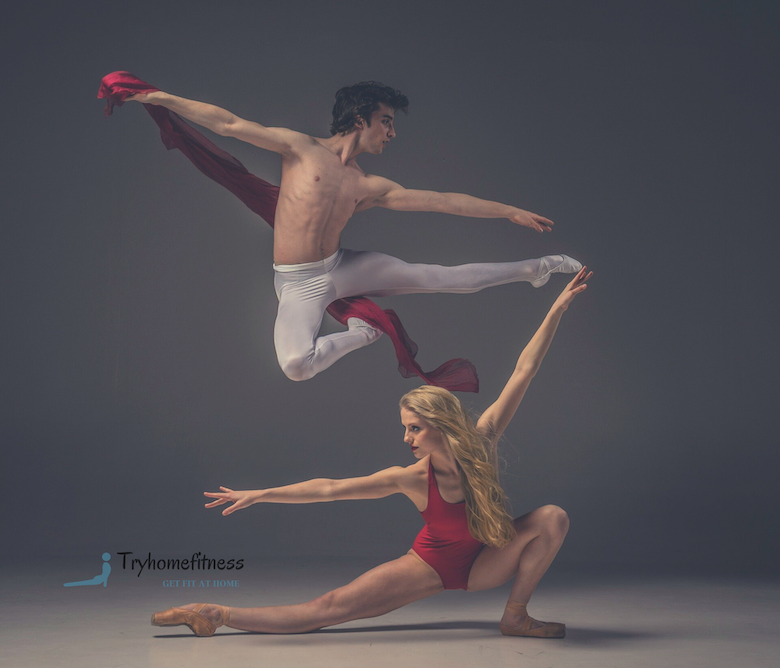


However, for the complete fitness package, exercises for these benefits would be stretching, yoga or simply practicing techniques like balancing. If you feel unsteady on your pins, it’s surprising how quickly you’ll see improvement. A chair is a good piece of equipment then but we won’t be explaining that.:D
A Word on “Workout Preparedness”
Being mentally keen and ready is one thing and a positive thing but it’s also important to choose the right accessories to get the most out of any workout.
Suitable shoes and comfortable clothing are the two obvious things to think about. I like to have a nicely textured gym towel next to me when I’m working out to wipe my face – yeah I sweat a lot.
A long run or hike means a whole set of items to think about. Use a comfortable backpack and keep a checklist to make sure you have everything.
Footwear
There’s nothing worse than a pair of ill-fitting shoes when you’re trying to get through your sweaty workout. Don’t skimp on sub-standard footwear. The APMA (American Podiatric Medical Association) advises us to stick with “sport-specific” footwear.
The benefits of choosing the correct footwear include:
- Lowers the risk of injury.
- Helps in muscle function.
- Decreases soreness in joints.
- Gives support and comfort all-around.
Apparel
When it comes to your clothing choices, you’ll want to focus mainly on comfort and practicality. For example, wearing roomy sweatpants could distract you on the treadmill, whereas wearing these while weightlifting might be more suitable.
If you feel comfortable in your clothes then it is more likely you’ll perform well.
As with shoes, many brands cater to sport-specific clothing lines from running to climbing and more. Don’t be fooled by high-end labels offering luxurious and too-specific options. Instead, keep your comfort a top priority.
Body Support
Do you have a pesky knee, you still want to train and are looking for a way to lessen the pain during exercise? A brace or sleeve might be the perfect solution for you.
The fitness world isn’t short on body-support options that help keep us safe while exercising. There’s no need to throw in the towel just because you’re not in tip-top shape.
However, be careful and don’t go over the threshold of what you know deep down will be drawbacks to come. Listen to your body and if you have to rest, then rest. Get back on the horse again slowly.
Supports, these days, come in the form of sleeves, straps and belts for all areas of the body. Using such accessories can make you feel more secure about the muscle group that you’re protecting when exercising as well as lending some comfort.
Gym Equipment Names, Types, Uses, etc.
Are you ready to jump into the gym equipment names and uses with images?
For each piece of equipment listed, we include:
- A brief description with types.
- What the equipment is best for.
- Pricing range.
- How to use the equipment.
The best gym machine names with images feature a wide array of options.
Cardio Machines
We’ll stick with the 6 most popular types of cardio machines and here’s what they can offer:
1. Treadmill
A treadmill allows you to walk or run in one spot—meaning you can go for a jog in your house. These machines typically feature side rails you can hold on to for safety.
The pace at which the treadmill’s belt moves determines the speed at which you go. Your options include anything from a brisk walk to sprinting. Some offer an incline choice to take your workout up a notch.
Types of Treadmill
The two most common types of treadmills are:
- Manual: These you operate with your legs meaning there’s no electricity involved. You determine the speed by your own movement, which reduces your risk of injury when getting on or off. They contain a natural incline by design, offering a challenging workout.
- Electronic: This is the treadmill type most often found at a gym. You control the speed and other data via the screen on the front. Options include incline, heart rate, steps taken, calories burned and even some preset workout programs. If you want to track your progress, stick with this type.
Treadmills are Best For
If you enjoy walking or running but find the outdoor conditions are difficult to manage, a treadmill might be a good fit. There are no potholes to look out for or poor weather scenarios to consider.
For those new to working out, treadmills are one of the easiest options. The preset workout programs can offer guidance and motivation to boot. Exercising on a treadmill mainly works the lower body targeting the glutes, thighs and calves.
Are you short on space? Many treadmills fold up to help with that.
Pricing
Treadmills can range anywhere from $300 to $3000, with the manual type being the most budget-friendly design overall.
For more information, we have written up guides and reviews of treadmills.
How to Use a Treadmill
2. Elliptical/Cross Trainer
An elliptical trainer simulates the motions of walking, running or climbing. Unlike the treadmill, there’s no belt. Instead, it features two steps that you propel in an ellipse-like motion, hence the name. Many provide a reverse option, so you can work other muscle groups that a treadmill doesn’t offer you like the hamstrings.
There are also corresponding poles for each pedal where you place your hands and move them back and forth as you go. However, some feature handles that are stationary.
Types of Elliptical
The three most pervasive types of ellipticals include:
- Standard: This type lets you assume a similar position as you would while walking or running. It comes with a screen through which you can control the resistance and other features. It’s the most common option.
- Cross trainers: These provide a similar workout to that of the standard elliptical, but with this one, you’re seated. For those in rehabilitation or their later years of life, this type could be beneficial.
- Gliders: These look the same as your standard ellipticals, though the main difference is that you glide, not step. The pedals slide back and forth versus using the circular motion. Stationary handlebars complete the basic design.
Ellipticals are Best For
Are you looking for another way to work the lower body? An elliptical can serve you well. Depending on if the poles are stationary or not, you might get an upper-body workout while you’re at it.
They’re also considered a “low-impact” option. This means it’s ideal for the joints and less stressful on the body all-around than other types of cardio such as running.
If you want to engage the calves and hamstrings, the reverse pedal option lets you work those areas too.
Pricing
Elliptical trainers typically cost between $300 and $3000.
For more information, we have produced guides and reviews of elliptical machines.
How to Use an Elliptical Trainer
3. Rowing Machine
Rowing machines are designed to mimic the movements of watercraft rowing. They feature a seat with pedals directly in front and a handlebar that you hold. As you pull, you bend the knees then straighten again as you release the handle forward.
This pulling motion is what simulates the oar’s movement across the water, using resistance to get the workout you’re aiming toward. They sport a screen that measures your distance and speed.
Types of Rowing Machines
The most common types of rowing machines are:
- Flywheel: These get their resistance from a spinning flywheel. Pulling on the handle causes the wheel to spin and create wind resistance. The harder you pull, the more air is generated, increasing the resistance. They provide a natural, smooth stroke.
- Magnetic: This type incorporates a magnetic brake system to create resistance. A metal flywheel spins as you pull on the handle, moving closer and further away to the magnet. These machines are virtually silent, as opposed to the windy sound you receive from the flywheel.
- Hydraulic: This style is usually the most economical option of the three. Tension is created from fluid or air that’s compressed within the machine’s cylinders. Unlike the two options above, the motion isn’t as smooth.
Rowing Machines are Best For
Rowing machines provide an excellent chance at a full-body workout. You’d be amazed at the various muscle groups you can strengthen and condition with rowing including both the upper and lower body.
Some doctors believe it’s more effective than other types of cardio, targeting up to 85 percent of your musculature.
It’s yet another low-impact option, so your joints should be safe here.
Pricing
Rowing machines can vary from $200 to $2000.
For more information, we have produced a rowing machine guide and reviews.
How to Use a Rowing Machine
4. Stationary Exercise Bike
This is one of the most common pieces of equipment that you’ll come across in the gym and for home use. The name gives it away as it resembles a stationary bicycle without the normal wheel configuration.
Depending on the style, your position will differ whether you’re leaning into the handles or seated more upright. Some require the use of motors and others use a flywheel system, similar to that you’d find in a rowing machine.
Types
They usually fall into one of three categories:
- Upright: This type of bike operates with a motor and electromagnetic resistance. Most of them feature a screen that allows you to control the resistance and track your vitals. They work more muscles than recumbent bikes featured below.
- Recumbent: This version is unique in that you’re seated in a semi-reclined position, versus sitting up tall on a saddle. The seat is about the same height as the pedals and some come with backrests. It could be a viable option for those recovering from injuries or anyone with other physical limitations.
- Spin: This type of bike is used in such a scenario and features a weighted flywheel system. Resistance varies based on your settings including an incline option. They are a pared-back version of the upright bike with the emphasis and speed and interval training. Does your local gym offer spin classes? You can also use spin bikes for home use and use individual or class programs
Exercise Bikes are Best For
Similar to outdoor biking, these units help with lower-body strength. They can also work your core and back. The smooth movement provided by all three types makes it a low-impact option.
If you’re looking to cross-train or work some interval training into your routine, these bikes are a good route to take.
Pricing
They generally range from $150 to $1500, while the upright versions are usually the most cost-effective.
For more information, we have produced guides and reviews of exercise bikes.
How to Use an Exercise Bike
5. Stair Climber
Using a stair climber resembles the movement of walking up a set of stairs, except that you do it continuously. They come with guard rails and depending on the style, there could be a stair-like design, while others sport basic pedals/steps.
It produces resistance against gravity which increases your strength in return and you can also control the intensity or speed on the machine.
Types
The two main types of stair climbers are:
- Stepmill: Imagine a revolving staircase and that’s a stepmill. It features a motor with a rotating belt that causes the steps to cascade. This type means that your foot will lose contact with each step as you move along.
- StairMaster: Unlike a stepmill, a StairMaster (or step machine) has two independent pedal-steps that move up and down to mimic the motion of walking upstairs. They feature handlebars that move in tandem with the pedals, which your feet don’t leave during the workout.
Stair Climbers are Best For
Like many cardio machines, the stair climber makes use of your lower-body muscles including the quadriceps, calves, hamstrings and glutes (source). For those with sensitive knees, building your leg strength is a significant benefit here.
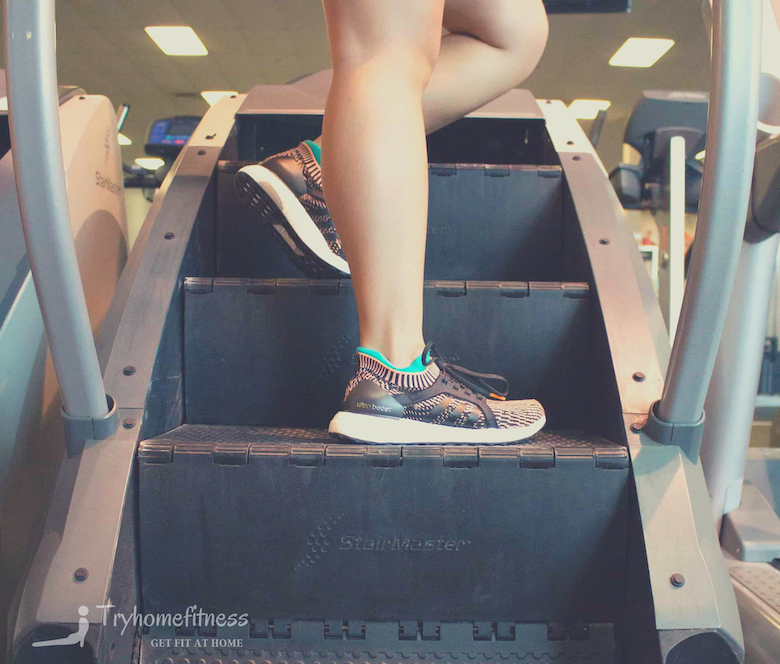


One of the main advantages of this piece of exercise equipment is that it mimics a movement everyone knows well. That indicates that it doesn’t take much workout prowess to get comfortable with the machine.
Pricing
Stair climbers are some of the most expensive pieces of exercise equipment on the market, ranging between $2500 and $10,000.
How to Use a Stair Climber
6. Vertical Climber
These machines are lesser-known but one of the only full-body workout options on our list. How? Well, as you might have guessed, based on the name, vertical climbers resemble what one would do when using a climbing wall or climbing outdoors and the resistance if any is increased to make the workout easier rather than harder. So the natural resistance is coming from your own bodyweight.
Vertical climbers feature two steps with long poles attached sporting handles at the end. This is where you place your hands, moving your upper and lower body together as you go along. The arm and leg on one side go up as the opposing limbs go the other way. It requires some coordination and is not for the faint at heart.
Types
There isn’t much variety when it comes to vertical climbers. The most standard option is a basic metal structure with foot pedals and handlebars that move in tandem as you “climb” up and down.
Some can fold and be stored away. They might offer a screen to track vitals and adjust your resistance level, while others are more straightforward.
Vertical Climbers are Best For
A really true full-body workout and one of my favorite workouts although they are tough. If you’re up to the challenge of working your upper and lower body simultaneously, a vertical climber will deliver. It makes for a high-calorie burn because of this.
If you want to improve your balance and coordination, this machine can help with that as well. We find it best for those with previous workout experience but to each their own. Beginners might find it enjoyable, so long as they can stick it out.
Pricing
They’re one of the more affordable pieces of cardio equipment, ranging between $100 and $1000, depending on the additional features included.
For more information, we have produced a guide and reviews of vertical climbers.
How to Use a Vertical Climber
Strength Equipment
The following gym equipment names and pictures cover our beginner’s strength-training module. We include a few of the most popular machines, free weights and more.
For the machines section, we’ve grouped them into the following categories: upper body, lower body, abs and glutes.
Upper Body
1. Chest Press
Similar to a bench press but sitting upright, this machine targets the pectoral muscles. It poses less risk than the former because there’s no chance of dropping the weights down on you.
To use it, you grab onto the handles in front and push them away from your body, then slowly bring them back again.
Chest Press is Best For
Chest presses make for a great option if you need to strengthen your pecs, biceps, shoulders and upper back muscles. Daily activities that require the use of your upper body will see improvement, whether lifting heavy items or pushing a stroller.
Using the machine versus free weights also helps you to maintain consistent form, which is a major advantage. This way, you ensure the targeted muscles remain the focal point.
Having said that, again, it’s a pretty expensive piece of gym equipment and will take up a lot of space even if you have a separate gym area.
Pricing
You can expect to pay anywhere from $800 to $3000 for a chest-press machine.
How to Use a Chest Press
2. Pec Deck/Machine Fly
The pec deck is a seated machine that contains two vertical posts with adjustable weights attached to them.
You squeeze the posts together from both sides to the center, in an arc-like motion.
Your elbows remain at an angle throughout the process, while the arms and hands meet in the middle and retract back out again.
The Pec Deck is Best For
According to the American Council on Exercise, the pec deck is one of the best options for strengthening the chest muscles. I love the pec deck. You can see results fast although it’s best not to be too ambitious with the weight when starting out as you can easily twinge the muscles in your side or back.
It targets the shoulders and the side muscles as well, including the serratus anterior, which runs along the upper ribs.
If you participate in any activities that require you to swing or throw something, this machine can help you better your performance and strength.
Pricing
Pec decks range between $500 and $4000.
How to Use a Pec Deck
3. Lat Pulldown
Last but not least, in our upper-body section, the lat pulldown is a popular activity for strength training.
It’s a seated structure that features an overhead pulldown bar that correlates with adjustable weights down below. As you pull down, the weights move up, returning to their position as you slowly release the bar upward. Most lat pulldown machines feature a padded bar under which your knees or thighs sit. This keeps you stable and your feet in place.
The Lat Pulldown is Best For
It’s easy to forget about the muscles in your back and the lat pulldown is one surefire way to target the largest muscle (the latissimus dorsi) in that area.
You also work other muscles here including the rhomboids (along the spine) and stabilizers such as the rotator cuff, the area around the shoulder.
If you sit at your desk all day, this is really beneficial for strengthening the back and improving posture.
Pricing
You’ll pay anywhere from $200 to $5000 for a lat-pulldown machine.
How to Use a Lat Pulldown
Lower Body
1. Leg Press
A leg press is a seated machine that typically comes with an adjustable incline and handles to either side. Weights are loaded on the other end and attach to a platform where your feet go. You then push this platform up and away releasing the load back.
The Leg Press is Best For
A leg press machine targets the quadriceps, hamstrings, calves and glutes, though the main focus is on your thigh area.
One of the advantages of the leg press is that you’re fully supported with a backrest, as opposed to squatting, which uses similar muscles. The handles provide further stability as you concentrate on strengthening your legs. This makes it a suitable option for beginners to strength training.
Pricing
Leg-press machines range from $1000 to $7000.
How to Use a Leg Press
2. Hack Squat
A hack-squat machine is used to perform weighted squats. It handles your form and leaves the rest up to you. It’s a staple option in most commercial gyms, due to the popularity of squatting.
You stand on a platform or the floor with your shoulders under the pads as you push down and back up again.
The Hack Squat is Best For
Squats are a wonderful way to strengthen your quads, hamstrings, hip flexors and glutes, while also activating your core muscles. This can benefit you greatly when it comes to general life activities like getting up and down, for example.
They also allow you to strengthen your tendons and ligaments, reducing your risk of injury.
Pricing
Hack-squat machines run around $1000 to $3000.
How to Use a Hack Squat
3. Hamstring Curl
While most lower-body machines primarily target the quads, the hamstring-curl machine focuses on, you guessed it, the hamstrings. This comprises the main muscle group in the back of your legs.
It’s a seated structure that features a padded rod with adjustable weights attached. Instead of lifting the rod up you place your legs over it and press down.
The Hamstring Curl is Best For
Using a leg-press machine is ideal for isolating the muscles on the back of your legs. It can be tricky to target that area with most other resistance machines.
Given hamstring injuries are a common ailment, especially among athletes, working them is crucial to the overall strength and stability of the lower body.
Pricing
Hamstring, or leg-curl machines, range between $500 and $2500.
How to Use a Hamstring-Curl Machine
Abs
Ab-Crunch Machine
The abdominal crunch machine isolates and engages abdominal muscles, which we all love to target within our workout sessions, hoping that magically the 6-pack will emerge from beneath the layer of unwanted fat.
The structure features a dangling seat, which moves as you pull your upper and lower body closer and release.
The motion that’s required to perform ab crunches on this machine doesn’t need much input from your arms or legs. This is why it’s full-core power here.
The Ab-Crunch is Best for
Targeting your core not only gives you rock-solid abs. It can also improve your posture and will help decrease back problems, which many of us have suffered from in the past.
This machine also works your obliques, which sit on either side of your abs and can further help with balance and a more toned midsection.
Pricing
An ab-crunch machine can cost you anywhere from $400 to $2000.
How to Use an Ab-Crunch Machine
Glutes
Butt Blaster
A lot of people skip butt day, but this machine will give you no excuse. A butt blaster is a great way to target your glutes.
It’s a horizontal structure with padded rests for your forearms and knees. At the back of it are the weights that you push up one leg at a time, much like donkey kicks.
Butt Buster is Best For
As you may have guessed – your butt! Strengthening your glutes can help with an array of other areas too including your lower back, knees and hips. Not only will you have a nice-looking bum but your joints may be relieved in the process.
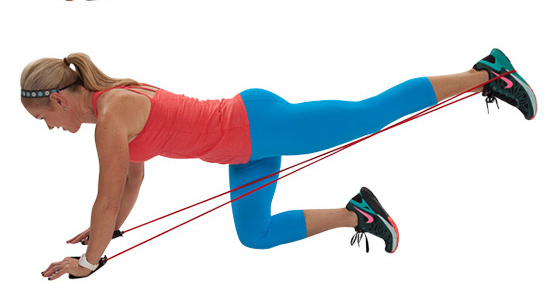


A but buster machine is another big commitment in terms of home space and cost for meager-seeming benefits. The same movements and therefore engaged muscles could be achieved by using resistance bands.
Pricing
Butt blasters typically range from $300 to $2000.
How to Use a Butt Blaster
Free Weights
Not all fitness transformations happen with the use of machines alone. Sets of weights alone can often do the job of several dedicated machines certainly when the upper body is concerned. Here are the most commonly-used options:
1. Barbells
A barbell is a long steel bar that can either serve as a loading platform for weights or you can use it on its own. Most of these weigh around 40 pounds solo.
Although there are many variations on the basic barbell, there are two major types of straight bar: standard and Olympic weightlifting. Olympic barbells are more expensive because they’re typically made from higher-quality materials and intended for use only with Olympic-style weight plates.
Uses
There’s a multitude of exercises you can perform with a barbell, which will work a range of muscle groups, including:
- Deadlifts.
- Barbell curls.
- Squats.
- Hip thrusts.
We have gone into more detail with reviews of our favorite barbells.
Pricing
Standard barbells range from $30 to $200, while Olympic barbells can set you back anywhere from $150 to $1500.
2. Dumbbells
Dumbbells are handled weights and come either fixed or adjustable.
Fixed dumbbells mean the weights are preset and built-in, so you can’t customize the load. Adjustable dumbbells, on the other hand, allow you to slide different-sized weights on and off what is effectively a little barbell.
Uses
Much like with barbells, there’s a wide variety of muscles you can target and exercises to perform here including:
- Dumbbell curls.
- Swings.
- Weighted squats.
- Dumbbell flys.
We have gone into more detail with reviews on some of the best adjustable dumbbells.
Pricing
This will depend primarily on the weight of the dumbbell. It can range between $10 and $1000.
3. Weight or Bumper Plates
Weight plates are designed to be used with a barbell and come in a standard size or made specifically for the Olympic variety. They slide onto either end and are often secured by a collar.
Uses
The weights can even be used alone with exercises like the Russian twist or weighted ab crunches.
Other workout options include:
- Romanian deadlift.
- Lunges.
- Overhead press.
- Power lean.
We have gone into more detail with a guide & reviews of some of the top bumper plates.
Pricing
Weight plates can range from $10 to $300, depending on their size and quality.
4. Kettlebell
Kettlebells differ from dumbbells in their shape and the types of exercises you can perform with them. The weight of the kettlebell is attached to one round handle. This provides resistance as it’s dangling toward the ground.
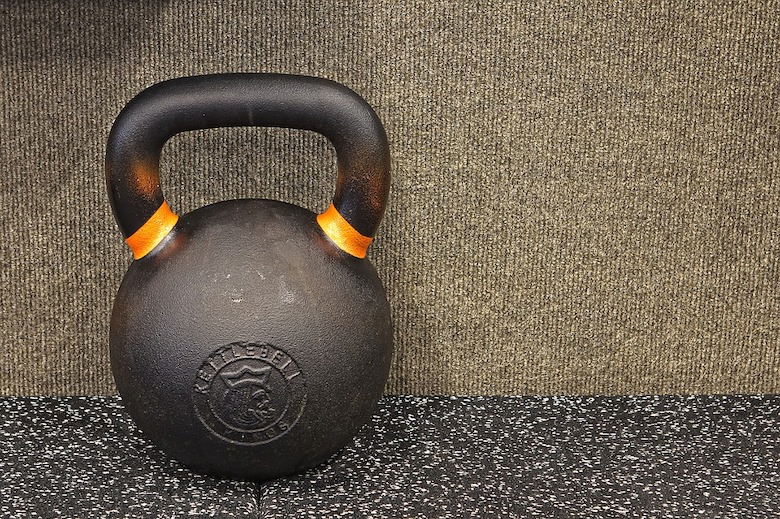


The design offers a smooth, free-flowing movement making it a popular option with intensive training programs like CrossFit.
Uses
Exercises to execute with a kettlebell include:
- Swings.
- Deadlifts with a high pull.
- Tricep press.
- Figure eights.
- Bent-over rows.
Pricing
Kettlebells can range from $15 to $200.
Clothing & Accessories
The shoes, clothing and body-support accessories we choose can have a significant impact on our performance and comfort level.
Footwear
Wearing the wrong shoes when working out can place undue stress on the joints. You want to make sure you choose the right footwear for the specific exercise you’re doing:
Shoes for Cardio
Training shoes are designed to absorb the impact with every step you take—reducing the weight-bearing effect on your joints. Furthermore, they’re made for comfort and wicking away moisture including sweat.
For those participating in other exercises aside from running and walking, you’ll choose a comfortable cross trainer with proper arch support. Other features being:
- Cushion at the heel and forefoot for runners.
- Support a natural stride.
- Round and stiff heel for walking.
- Made from breathable materials like polyurethane.
Shoes for Strength Training
A stable foot stance is essential for weightlifting activities, which means a shoe with a flat, sturdy base is what you’re after. Believe it or not, you’ll see many wearing something like a typical Converse trainer when working out.
Olympic lifting, however, requires special shoes. They contain a rigid sole with a slight lift in the heel—this enhances the stability of the foot for powerful weight transferrals.
We’ve produced some guides and reviews on specific types of athletic shoes.
Clothing
The type of clothes you wear does make a difference when exercising. Stick with basic pieces from the categories below, depending on your chosen activity:
Loose-fitting:
- Walking.
- Resistance training.
Stretchy, form-fitting:
- Running.
- Biking.
- Other cardio.
Materials and Layering
Fabrics made of polyester and polypropylene are best for most activities as they help you stay dry and fresh. It’s best to avoid cotton as it absorbs sweat but doesn’t dry quickly.
If you’re working out in the colder months, ensure that you start with multiple layers of clothing, removing them as your body temperature increases.
Compression Pieces
The use of compression clothing and how it can benefit your workout is up for debate. However, some studies show that it can improve the athletic performance of serious athletes by reducing swelling and increasing body temperature.
Some choose to wear compression clothing because it tends to smooth over the bumps and less-appealing parts of the body. You can find tank tops, shirts, shorts and leggings made from these materials.
I’m a big fan of compression tops and always wear one whether running or gym work. I sweat more than most women and nothing beats the modern compression shirts for wicking.
I also feel comfortable in them as, yes, they pull in all the spare bits but that enhances the feeling of preparedness when working out. Got loads. Love ’em.
Body Support
For those with joint-specific issues such as sensitive wrists, knees or ankles, using a supportive accessory can mean a more comfortable (and safer) workout. Furthermore, there are special options where strength training is at play.
The most common accessories include:
Compression Sleeves
Compression sleeves are a good common solution to a problem. They protect the joints from future injuries through the use of compression. They can improve blood flow, reduce pain, provide stability and extend your range of motion.
They’re commonly used for the knees and ankles and can also be useful for those that have sustained an injury previously or are undergoing rehabilitation.
Weightlifting Belts, Straps and Gloves
Have you ever seen a weightlifter on TV wearing a leather belt? This is just one example of body support that helps protect and stabilize the back when lifting heavy loads.
Straps, however, wrap around the wrist and then you place the excess material under your hand where it meets the barbell. These can come in handy when you need to protect your palms from the grating on the bar.
They can also keep you from slipping, which is useful when you’re just starting out and want to improve quickly.
Gloves are another option to help improve your grip when lifting weights. A pair of these are useful if you’re worried about your wrists. They can further reduce the chance of calluses or blisters forming.
Final Thoughts
The thought of achieving your dream figure and obtaining ultimate health can be exciting. However, there’s no need to splurge on all of the equipment pieces and items mentioned here to do that.
When starting a workout program, it’s ideal to get a feeling for what you enjoy doing the most. Then you can begin acquiring the things that best fit your routine or look for what might be a more simple alternative.
The above guide on gym equipment names will hopefully help in understanding many of the machines out there. Keep the practicalities of budget and space if you’re thinking of investing in any of the larger fitness machines.
Are you after cardio, strength training or both? Few things are better than the feeling of being able to work out on your own time, in the comfort of your home with a personalized setup.
I know there’s a lot we’ve left out but we will be adding to this list to make it a giant guide to all the available exercise gear in the near future.
Let us know your thoughts on our beginner’s guide to gym equipment names in the comments. Give it a share if you’ve found it helpful.

